Final report for FNC17-1082
Project Information
I run an 8 acre farm and homestead with my partner Eric. We raise dairy goats, laying hens, and ducks on a small scale. We grow a wide variety of crops with an emphasis on nightshades, alliums, sweet potatoes, early/late season greens, and berries. We grow outdoors as well as in a seasonal high tunnel, and use sustainable practices such as cover cropping, interplanting, and rotational grazing. Much of our produce and protein currently goes to our own pantry and to friends and neighbors, but during the warm season we market goods at our self-service roadside farmstand. We have occasionally sold produce through a CSA-type program and a healthfood store. We also hold annual music festivals on our farm and would like to capitalize on our scenic location by venturing into other agritourism projects.
This project will contribute to the economic, social, and ecological sustainability of our food system by facilitating collaboration between farms, helping farmers find resources to succeed, increasing consumer awareness of locally available farm products, and engaging the greater community including youth, organizations, businesses,and government in the local food economy.
The overall goal of my project was to get more locally and sustainably-grown food to more people in and around my county. Based on my observations while participating in various efforts to do this, I determined that it would be helpful to take a step back and assess the current state of our local food economy, use the information to build a support network of farmers, then engage potential consumers.
Specific Project Objectives:
Contribute to the economic, social, and ecological sustainability of our food system by facilitating collaboration between farms, helping farmers find resources to succeed, and increasing consumer awareness of locally available farm products.
Decrease reliance on fossil fuels for transportation by improving local marketing channels; spread knowledge about ecologically sound agricultural methods such as water conservation, cover cropping, and rotational grazing; and reduce food waste by educating consumers.
Help farmers save money by sharing tools and equipment, exchanging labor with each other on large projects, and bulk ordering supplies; provide labor to farmers through youth internship; connect farmers with financial and technical resources; increase local sales by raising consumer awareness; and save consumers money by buying directly from farmers.
Create opportunities for social interaction among farmers and between farmers and community members, connect youth with farmers and their community, free up time for farmers, and increase public access to fresh, healthy foods.
I proposed to do this through:
Conducting interviews with local farmers to identify their products, production and marketing methods, future goals, and barriers to success. This information will be compiled into a farmer directory, and will be used to create a resource guide to address farmer needs such as financial assistance, technical advice, marketing information, growing information, food safety rules, legal advice and agricultural suppliers. (The directory was not created)
Holding Four “Farm Summits” (once a season) to bring farmers together to facilitate collaboration. We will discuss season plans, coordinating plantings to meet demand, cooperative marketing opportunities, bulk ordering, tool and equipment sharing, labor exchanges, and share knowledge and experiences. This will also provide a much needed social outlet!
Coordinating a youth farming internship to give high school students the opportunity to learn about growing food by working on local farms. This program will make youth more invested in the community and allow them to explore farming as a career, and the extra help will also benefit farmers. (This portion was not completed)
Publishing four seasonal newsletters to educate consumers about local foods and farms by profiling area farms, listing locally available products and where to get them, sharing recipes for seasonal produce, listing relevant local events, and providing sustainable farm and garden tips. Because of the considerable positive feedback, I decided to publish these newsletters eight times a year instead of quarterly.
Organizing a “Local Foods Showcase” event to highlight local farms, allow farmers and consumers to interact, and educate consumers about what is available. (This was not completed)
I also proposed to meet with local stakeholders including government officials, local businesses, civic organizations, and other non-profits to discuss starting a monthly farmers market in Gainesville.
Research

My research consisted of farmer interviews, and surveys. I have interviewed and/or surveyed 26 farmers, including myself. This project combined research and action to meet local needs, so as I collected data, I tried to make choices about how to proceed.
Interviews:
My 11 farm interviews were open-ended and conversational. I tried to mainly listen and capture what they identify as most important. We talked about what they are producing, how much, what methods they use, how they market or otherwise distribute their farm products. I also asked how long they have farmed and what their motivation and goals are, what they would like to see improve on their farms and in the local food community, and what inputs and other resources they use. After getting an idea of "where they are now" I steered the conversation toward future goals, and gather their ideas about being part of a greater local food economy. (see interview questions attached). Interview Questions
Participant Surveys:
These are intended to gauge the current ecological, economic, and social sustainability on local farms. (See pre-survey attachment) Pre-survey
Interviews
I conducted interviews at 11 farms.
Ten of the farms are producing annual and perennial food crops, and some livestock primarily for their own use. One of the farmers earns their primary income from beekeeping, another from selling native plants. The biggest challenges that have emerged are driving distance, and lack of markets for buying or selling sustainably produced items. All of those interviewed so far expressed some level of interest in collaborating with other farmers. The desire for a community gathering space was also a common thread.
Surveys
20 farmers (including myself and 7 of the farmers who were also interviewed) completed the pre-survey, which was distributed at the farm summits.
All farmers reported currently using at least some ecologically sustainable practices, with mulching and crop rotation most frequently cited. Many identified room for further improvement, with water catchment systems, permaculture techniques and decreased reliance on outside inputs appearing most frequently. Fifteen of the 20 participants cited labor as a barrier to implementing additional sustainable practices, 9 cited funds, and 7 information.
Economic sustainability is definitely the weakest "pillar" among our farmers. Many participants left this section blank. When asked to rate their satisfaction with the amount of income your farm brings in (1 least satisfied- 10 most), ten farmers chose 1-3, five answered between 4 and 6, and one answered 7, which was the highest rating selected. Two farmers stated that their products were reaching 10 or more people, but the rest either didn't answer, or wrote in 0 or "N/A". The majority of farmers surveyed are producing just for their own families (or fellow members of their intentional communities) and sharing excess with friends and neighbors. Seven people indicated that they used "direct to consumer" marketing, three cited online marketing, and three wrote in "barter". I later re-worded this section in order to gain more useful information from people who are not selling their products for money, and two additional farmers selected "barter".
Regarding social sustainability, eleven participants rated their quality of life as 8 or above (out of 10), six participants selected 4 to 7, and no one chose a lower rating. This is encouraging, and is interesting to consider alongside the economic findings. Even though people are not making much money, they are happy farming. All but two participants indicated that they are currently collaborating with other farmers, most often through work parties or work trades, and bartering or sharing seeds and plants and farm products. Trading varieties to increase genetic diversity and general farmer networking were the most frequently identified ways that people would like to collaborate. Participants expressed a clear desire to be connected to a farmer support network.
Educational & Outreach Activities
Participation Summary:
Consultations : I conducted eleven interviews with area farmers. During the interviews, I collected information about what they grow and raise, what challenges they face, and their ideas about how to become better connected with the local food economy. I am estimating that I consulted with an additional 15 or so people via phone and email. Throughout the project people contacted me for information on where to get organic produce and my preferred varieties of various vegetables. I was also able to connect people needing help on their farms with people needing work on two occasions.
Published press articles, newsletters: An article describing my project was published in the Ozark County Times weekly newspaper.
Ozark County farm owner awarded grant to help build local food economy here
I also submitted an editorial about the Winter Farm Summit to the Ozark County Times, which is available here: Sowing Seeds for Food and Fun
A friend and project participant created this blog post and video interview about the Fall Farm Summit:Local Food Economy: Community Harvest Gathering
I have created and distributed eleven issues of the Ozarks Agrarian News, a submission-based newsletter that aims to build our local food and small farm culture. 25-45 paper copies of each issue have been distributed, and 179 people are on the online mailing list for the newsletter. A handful of others without internet access have requested print subscriptions. The newsletter has been very successful, and I plan to continue putting it out 8 times a year. Read the newsletter here
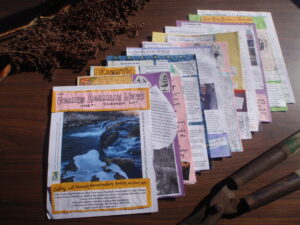
Tours: I spoke about my project and hosted a tour of my farm and high tunnel organized by the Ozark County Extension Office and Natural Resources Conservation Service on April 6th. Approximately 10 people attended.
Webinars, talks and presentations: I gave a presentation on my project on January 6, 2018 at a meeting of the Ozarks Neighborly Exchange, a local group that works together on agricultural projects. Fifteen people were in attendance.
I also gave a brief presentation on local food networking at a high tunnel workshop organized by NRCS and Extension on January 20, 2018. Approximately 40 people were in attendance.
Workshop / field days:
24 people attended the Winter Farm Summit at my farm on January 21st. It was originally scheduled for the weekend before, and 5 people attended on that date despite the snowy weather. We shared seeds and snacks, discussed plans for the coming season, discussed our favorite crops and varieties, and brainstormed about cooperative projects and infrastructure. Participants also helped build listings of locally available plants, livestock, farm products and services that they have or need, farm inputs and bulk goods that could be purchased cooperatively, and farm or community projects they would like help with.
35 People attended the Spring Farm Summit and potluck on April 14th. Everyone had a chance to share what they were working on and planning on their farms and homesteads, and we continued the discussion of how to make the local food economy more successful.
33 attended the Fall Farm Summit on October 21st. We discussed staple crops, time saving methods and tools, and how to work cooperatively. Participants brought produce, artisan goods, plants, and other items to sell and trade. We shared a potluck meal and several people shared their musical talents.
The best outcome of the farm summits was networking. Many new friendships and economic connections were formed and strengthened at these three events.
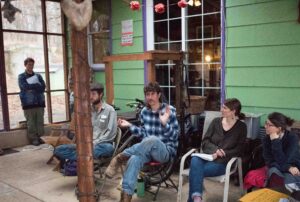
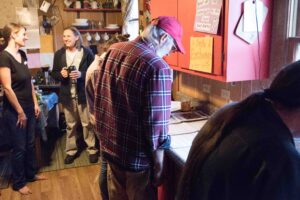
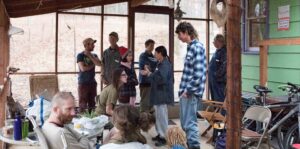
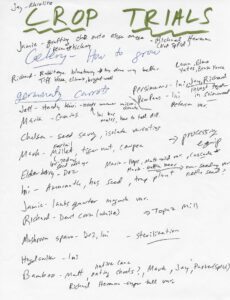
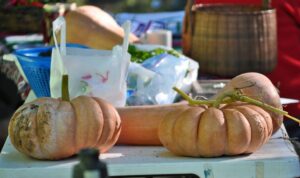
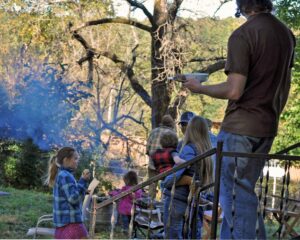
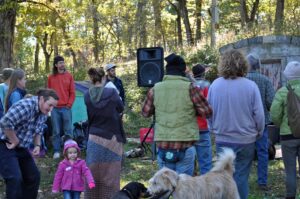
Learning Outcomes
Although I was not able to complete all of my proposed activities, I think this project had a very positive impact on the local farming community, and on me personally. Many valuable connections were forged, and many goods, ideas, and resources were exchanged throughout the project. Ironically, working on this project contributed to a decrease in productivity on my farm! However, I learned so much and built so many connections, that it was well worth stepping back production a bit. Like most of my fellow farmers, time and money are significant barriers, so it's only fitting that I have to overcome them if I am going to help others do so.
I gained a better understanding of our local food landscape over the course of this project. As I suspected, many of the farmers I have interacted with are operating on a very small scale, and are most interested in providing their own supply of fresh healthy food. Because there is no major market close by, very few of these small diversified farms have hopes of earning a significant income from farming. If we can connect all of these small farms with each other and their neighbors, and facilitate economic exchange between them, whether through barter or monetary sales, we can get good food to more people, and give farms the support they need to meet sustainability goals.
I would definitely recommend this type of approach to others that are looking to build their local food economy. My project was specifically tailored to the rural area that I live in, but I think many aspects of the project could be applied anywhere. Communication and distance are major barriers for us, and the newsletter and Farm Summits showed very positive results in getting people more involved and connected.
After a presentation I gave, an audience member commended my work, but asked how I stay motivated even when progress is so slow. I replied that major change takes time, and we have to accept that. In some ways it is challenging to work in a rural and independently-minded community, but with such a small population, every contact really makes a difference. For others interested in replicating this project, I would stress the importance of working with the local culture and landscape to build a food economy that works for their specific location.
We have a long way to go toward a sustainable local food system, and it may take a major change in circumstances to produce lasting change, but I think continuing to build a good knowledge base, economic framework, and community support network will make it easier for all of us to be successful.